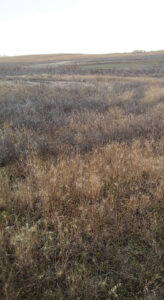Saskatchewan Bulletin
SaskCanola’s Recent Investments Into Weed Research
SASKCANOLA CO-FUNDS IMPORTANT RESEARCH on the management and study of weed populations, with a focus on weeds that are important to canola production. Several of these projects involve screening weed populations for baseline levels of resistance to several classes of herbicides.
This screening provides useful knowledge for researchers to compare to future data and determine how quickly herbicide-resistant (HR) weed species are spreading across the Prairies, as well as which herbicide modes of action are most at-risk of becoming ineffective. Herbicide stewardship, with proper herbicide rotation across the entire crop rotation, is key to maintaining a diverse choice of herbicides for a longer period of time.

Shaun Sharpe, research scientist with Agriculture and Agri-Food Canada (AAFC) in Saskatoon, is most concerned with the risk of Group 14 herbicide resistance arising in kochia on the Prairies. “This mode of action has pre-emergence, post-emergence, desiccation, and post-harvest application timings. The later timing, desiccation and post-harvest may mean kochia is a lot larger and harder to kill,” Sharpe says.
This poses a risk for developing HR weeds because of increased selection pressure from applying the same herbicide mode of action. This can happen whether it is applied multiple times within one growing season or if the same herbicide is applied year-after-year on the same field. Unfortunately, we are running out of modes of action that are effective against this weed, and that is why herbicide stewardship is so important.
Breanne Tidemann, research scientist at AAFC Lacombe, currently leads a SaskCanola co-funded project to learn more about cleavers populations in Western Canada. Different cleavers biotypes may have early or late emergence, and some winter annual biotypes can overwinter. Biotypes with different emergence times require different management strategies. As well, some biotypes have been observed to have HR, so this project will evaluate the base-level of quinclorac resistance to see if any can be found in Western Canadian cleavers populations.
It is important to scout for herbicide resistant weed populations in your field after herbicide applications. For more best management practices and tips for controlling HR weeds, see manageresistancenow.ca
Robert Gulden, researcher at the University of Manitoba, recently started a project to update the critical weed-free period (CWFP) in canola. The previous CWFP recommendations were done 20 years ago. Since then, modern hybrids have greater seedling vigour and the ability to compete with weed species. Results from this research could mean that the CWFP will be shortened and potentially give growers the confidence to apply fewer herbicide applications in the canola growing season after the CWFP. However, plant stand densities are also a key factor in the ability of canola hybrids to compete with weeds. For this reason, different canola establishment rates, including rates below the recommended five to eight plants per square foot, will be evaluated for their ability to compete with weed populations.
Charles Geddes, research scientist at AAFC Lethbridge, is evaluating the economic thresholds for glyphosate-resistant kochia in canola in Western Canada. Specifically, Geddes and his team are looking at the threshold for using a two-pass herbicide system for canola varieties that have stacked glyphosate and glufosinate tolerance traits to control HR kochia. This threshold will depend on the density of kochia in the field and whether the second herbicide pass occurs after the CWFP. This project also evaluates whether the cost savings of reduced canola seeding rates causes a greater economic loss due to lost competitiveness against weeds, as well as the higher risk of evolving HR weeds.

Julia Leeson, research scientist at AAFC Saskatoon, is researching the composition of general weed populations in different regions and crops over time. The first iteration of the general weed survey began in the 1970s. The current survey, which began in 2019, is the sixth iteration on the Prairies. Each iteration of the survey spans several years and looks at the weed population dynamics of which weeds are becoming more prevalent and which species may become greater issues. This current survey sampled 2,277 Saskatchewan fields during 2019 and 2021 with similar numbers of fields to be surveyed across the three Prairie provinces by the end of the six-year cycle. In 2019, the top three weeds in Saskatchewan were green foxtail, canola and wild oats. With extreme drought conditions in 2021, this changed to green foxtail, wild oats and kochia. Full results for the Prairies will be available in 2024.
Shaun Sharpe leads another Prairie weed survey focused specifically on identifying populations of kochia and Russian thistle with HR to glyphosate or dicamba. The rate of increase in HR kochia over the last decade has been shocking, so it is advisable to use multiple modes of action to control kochia.
Sally Vail, research scientist with AAFC Saskatoon, is looking at causes and potential solutions to secondary dormancy in canola seed in a Canola AgriScience Cluster project. Secondary dormancy in canola seed causes germination to be delayed to the following crop season, triggering canola volunteers to be a dominant weed issue in many fields. Vail’s research aims to identify genes controlling this trait, with the goal of breeding canola with lower secondary dormancy, and lower numbers of volunteers in following crops.
Other resources
SaskCanola avoids funding duplicate projects, so we encourage you to look at other weed research projects by these and other researchers that are funded by other organizations. You can find other current or completed weed research projects at SaskCanola’s Research Results (search for “weeds” at saskcanola.com/research-results) or at the Canola Council of Canada’s Canola Research Hub (canolaresearch.ca). General information on weeds that impact canola production can be found in the Weeds section at canolaencyclopedia.ca.





